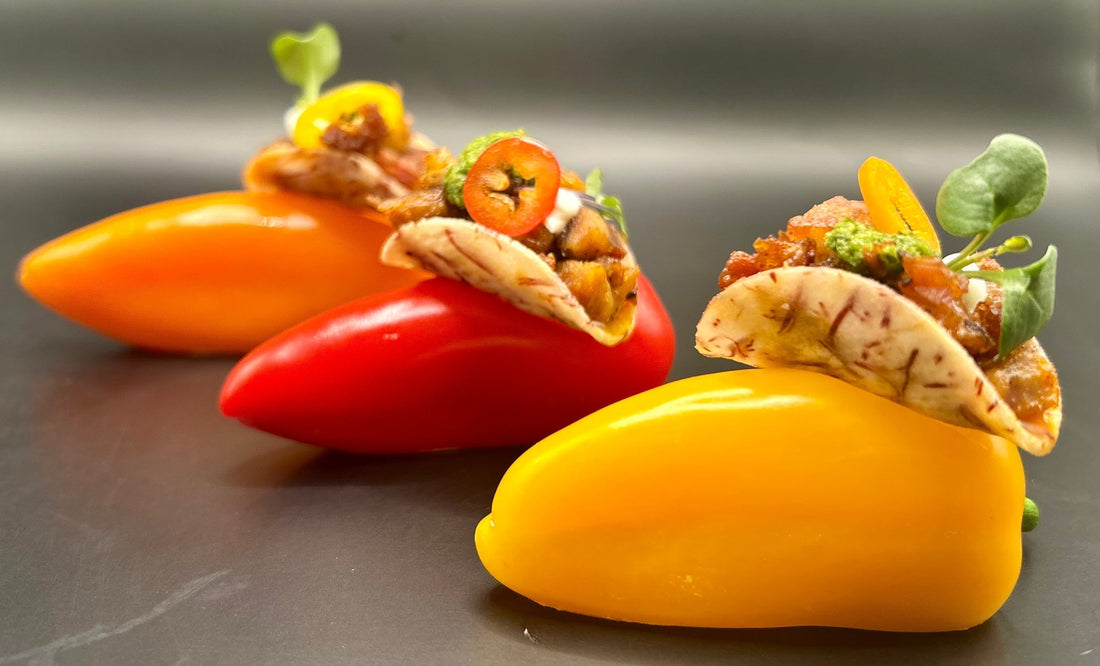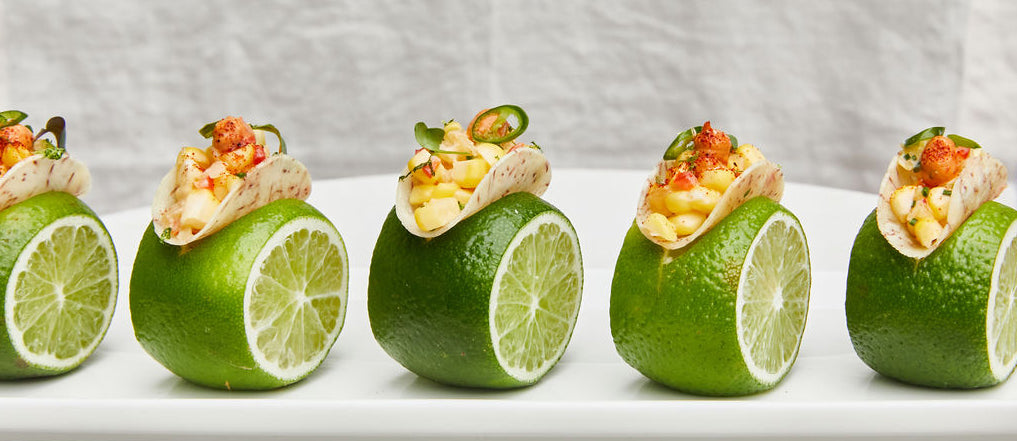
A Culinary Journey: Appetizers Through the Ages
_________________________________________________________________________
Introduction: Appetizers Through the Ages
An appetizer is a small dish served before a main meal to stimulate the appetite. These can range from simple items like olives or nuts to more elaborate preparations such as stuffed mushrooms or Gruyere and Crab Palmiers.
The smaller the appetizer size, the more elevated the dish often tends to be. In fact, most truly bite size appetizers are professionally made. This is where high end caterers thrive, making beautiful, tiny bites for your party.
Origins of Appetizers
Ancient Beginnings: We can trace back the concept of appetizers to ancient civilizations. For instance, in ancient Rome, the gustatio was served at the beginning of a meal. This consisted of small portions of fish, vegetables, cheeses, and olives. Similarly, ancient Greeks enjoyed small dishes called propoma before meals.
Medieval Europe: During the Middle Ages, formal French meals included entremets. They were secondary dishes served between main courses. These were sometimes actual food items. In other instances, entremets were elaborate displays. They brought dramatic or musical presentations to the meal.
The World's First Appetizer
Debated Origins: It's challenging to pinpoint the exact origin of the first appetizer. But many historians believe that the tradition began in Russia with zakuski. These small bites include fish, caviar, and meats. They were often consumed after long travels.
Other historians argue that appetizers may have originated in China. These spring rolls celebrated the season about 1400 years ago. That was before appetizers hot Russia, Scandinavia, France, and other European countries.
Types of Appetizers Through the Ages
Hors d'oeuvre: A French term meaning "outside the work". These appetizers are small dishes served before the main courses of a meal. They may be hot or cold and are often elaborate in presentation.
Canapés: Originating from the French word for "sofa," canapés are small, decorative finger foods. They consist of a base (such as toasted bread or crackers) topped with various savory ingredients.
Passed Appetizers: Also known as "butlered" appetizers, these are bite-sized foods. They're presented on trays by servers during events. This allows guests to enjoy them while standing and mingling.
Finger Foods: Small, individual portions meant to be eaten without utensils. Finger foods are often served at social events. Examples include sliders, chicken wings, and spring rolls.
Global Examples of Appetizers
Italy: Antipasto – A traditional first course featuring cured meats, cheeses, olives, and marinated vegetables.
Spain: Tapas – A variety of small savory dishes like patatas bravas, albondigas (meatballs), and jamón ibérico.
Middle East: Meze – An assortment of small dishes such as hummus, falafel, and stuffed grape leaves.
China: Dim Sum – Bite-sized portions of food traditionally served in small steamer baskets or on small plates, including dumplings and buns.
Russia: Zakuski – A spread of appetizers like pickled vegetables, cured fish, and caviar, often accompanied by vodka.

American example: Tiny Taco BK's Taro Root Bite-Size Tacos
In the current culinary market, innovative appetizers continue to emerge. For instance, caterers love a modern twist on the classics. Tiny Taco BK exemplifies how to do this with their taro root-based, bite-size taco shells.
These mini taco shells are a alternative to conventional corn or flour tortillas. They're made from taro root, a starchy root vegetable. Taro has a distinctive elegant look with purple dashes on pale white. It's also crispy and clean tasting.
Their petite size (about 1.75 inches across) and crispy good looks make Tiny Tacos a coveted appetizer. They serve as versatile vessels for a variety of savory or sweet ingredients. Vegan and gluten free, Tiny Taco BK's taro taco shells can delight every partygoer.
Fun Facts About Appetizers Through the Ages
- The term "appetizer" began in the United States and England. Both countries started using it in 1860.
- The classic American appetizer, Buffalo wings, originated in 1964. They kicked off at Anchor Bar in Buffalo, New York.
- In France, appetizers are often called "amuse-bouche," which translates to "mouth amuser."
- The world's largest cheese ball weighed over 1,000 pounds. This prize winner made dairy history in 2010 in Wisconsin.
- Deviled eggs date back to ancient Rome, where they often served as a first course for the wealthy.
Appetizers Before a Meal vs. Appetizers at an Event
Before a Meal: Appetizers served before a meal stimulate the appetite. These bite size treats set the tone for the courses to follow. They tend to be lighter and complement the forthcoming dishes.
At an Event: At many parties or receptions appetizers may be the primary food offering. These are usually more varied, special, and elevated. This food format allows guests to mingle and eat without the formality of a sit-down meal.
Timeline for Appetizers Through the Ages
15th Century: Bruschetta – To make this Italian antipasto, cooks grill this bread rubbed with garlic. They top it with olive oil, salt, and pepper. Simple and delicious, it's a challenge to find a gluten free alternative that lives up to this classic.
17th Century: Canapés – These treats originated as toasted or fried bread slices. They're then topped with a variety of dishes. Still popular today, many experiment with gluten-free options to better serve today's partygoers.
1920s: Deviled Eggs – These tasty ovals gained popularity in the U.S. as a classic picnic and party dish. Cooks boil the eggs then mix yolks with mayo. The mixture's then stuffed into egg white halves and dusted with paprika.
1950s: Pigs in a Blanket – Small sausages wrapped in pastry became a popular party snack in the 50s. These cute mini hot dogs have stayed a delicious appetizer through the ages.
1960s: Cheese Balls – For dairy lovers, cooks blend cheese varieties into a smooth sphere. Then they coat these balls with nuts. Cheese balls were all the rage during this decade. Partygoers dipped crackers and breadsticks into the balls for a creamy treat.
Conclusion
Appetizers are a global phenomenon. They've evolved from ancient traditions to the creative, bite-sized delights we enjoy today.
Whether it's the elegant canapés of France, the vibrant tapas of Spain, or Tiny Tacos from Brooklyn, NY, appetizers bring people together and set the stage for a delicious meal (or a whole night of snacking!).
Crunching into a bite size treat? Remember it's a culinary tradition dating back thousands of years. Bon appétit!
Sources
Libby O Connell (11 November 2014). The American Plate: A Culinary History in 100 Bites. Sourcebooks.
Adamson, Melitta Weiss (2004). Food in Medieval Times. Westport, CT: Greenwood Press.
Andrew F. Smith (1 May 2007). The Oxford Companion to American Food and Drink. Oxford University Press.
Olver, Lynne. "Sandwiches". The Food Timeline.
"Speakeasies, Sofas, and the History of Finger Foods |…". PBS Food.
"What is Antipasto?". www.thespruceeats.com. The Spruce Eats. 20 September 2022.
"Tapas, the Little Dishes of Spain". Living Language. 20 March 2012.
Speake, Jennifer; LaFlaur, Mark, eds. (1999). "Meze". The Oxford Essential Dictionary of Foreign Terms in English. Oxford University Press.
Gourse, Leslie (13 March 1988). "Dim Sum Has Come a Long Way, From Esoteric to Mass Popularity". Chicago Tribune.
"Zakuski". Culture and Customs of Russia. Greenwood Publishing Group. 2000.
Dhirendra Verma (1999). Word Origins. Sterling Publishers Pvt. Ltd.
Nicks, Denver (September 28, 2016). "Who Actually Created Buffalo Wings?". The Daily Beast.
Mackey, Dakota (19 November 2014). "Cheese Ball History". Culture (cheese magazine).
"Deviled Eggs History: From Rome to Your Home". November 2, 2018.
James Beard (5 May 2015). Hors d'oeuvre and Canapés. Open Road Media.
"bruschetta". Hannah International Foods. 2010.
James Beard, Hors d'Oeuvres and Canapés (William Morrow & Co., New York, 1943, 1963, 1985), p. xiii.

